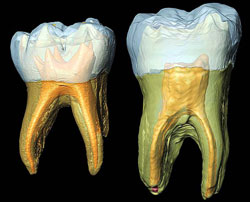The ESRF reveals how Neanderthal teeth grew

Three-dimensional virtual reconstruction of the deciduous and permanent Neanderthal molars. Both enamel and dentin are rendered in transparency to show the pulp chamber and the root canals. Credits: Luca Bondiolli and Arnaud Mazurier.
Neanderthals first appeared in Europe approximately 200,000 years ago and became extinct about 25,000 years ago. These predecessors of modern humans have always been considered genetically closer to us than any other members of the genus Homo. It has even been suggested that Neanderthals achieved adulthood faster than modern humans do today.
A research team from the United Kingdom, France and Italy has recently shed new light on this theory by studying this species’ teeth. Teeth express genetic differences found between individuals and different populations more efficiently than any other tissues preserved in the fossil record. Studies with teeth can identify a timescale on the entire period of dental development that occurs from before birth until adulthood.
Scientists used the ESRF X-rays to study the enamel dentine junction of a deciduous and a permanent Neanderthal molar tooth (approximately 130,000 years old) that was found on a site in France. The technique used to image the teeth is high-resolution tomography. The researchers noticed that the samples showed more complex folding of the enamel dentine junction than their modern human counterparts. Some of the unique surface morphologies of Neanderthal molars clearly showed a deep embryological origin and are likely to have been functionally significant.
Thin ground sections of the same Neanderthal molars revealed that the crowns and roots did not grow faster than those of modern humans. The permanent molar tooth studied had completed its root growth at about 8.7 years of age, which is typical of many modern human children today.
Almost all deciduous teeth contained an accentuated birth line, or neonatal line that results from the changing physiology and stress of birth. The Neanderthal deciduous also showed a neonatal line with evidence of the usual perinatal physiological stress but with no signs of additional postnatal stress.
Among anthropoid primates there is a close relationship between brain growth and tooth eruption. Scientists predicted that the first permanent molar eruption in this Neanderthal (6.8 years) fits a dental development schedule similar to those found in modern humans.
The next step in the research is to find out whether Neanderthal teeth from sites dated to more recent times will reveal evidence of the demographic pressures that overcame the Neanderthals as they approached extinction.
Media Contact
More Information:
http://www.esrf.fr/news/pressreleases/teeth2/All latest news from the category: Physics and Astronomy
This area deals with the fundamental laws and building blocks of nature and how they interact, the properties and the behavior of matter, and research into space and time and their structures.
innovations-report provides in-depth reports and articles on subjects such as astrophysics, laser technologies, nuclear, quantum, particle and solid-state physics, nanotechnologies, planetary research and findings (Mars, Venus) and developments related to the Hubble Telescope.
Newest articles

Superradiant atoms could push the boundaries of how precisely time can be measured
Superradiant atoms can help us measure time more precisely than ever. In a new study, researchers from the University of Copenhagen present a new method for measuring the time interval,…

Ion thermoelectric conversion devices for near room temperature
The electrode sheet of the thermoelectric device consists of ionic hydrogel, which is sandwiched between the electrodes to form, and the Prussian blue on the electrode undergoes a redox reaction…

Zap Energy achieves 37-million-degree temperatures in a compact device
New publication reports record electron temperatures for a small-scale, sheared-flow-stabilized Z-pinch fusion device. In the nine decades since humans first produced fusion reactions, only a few fusion technologies have demonstrated…





















